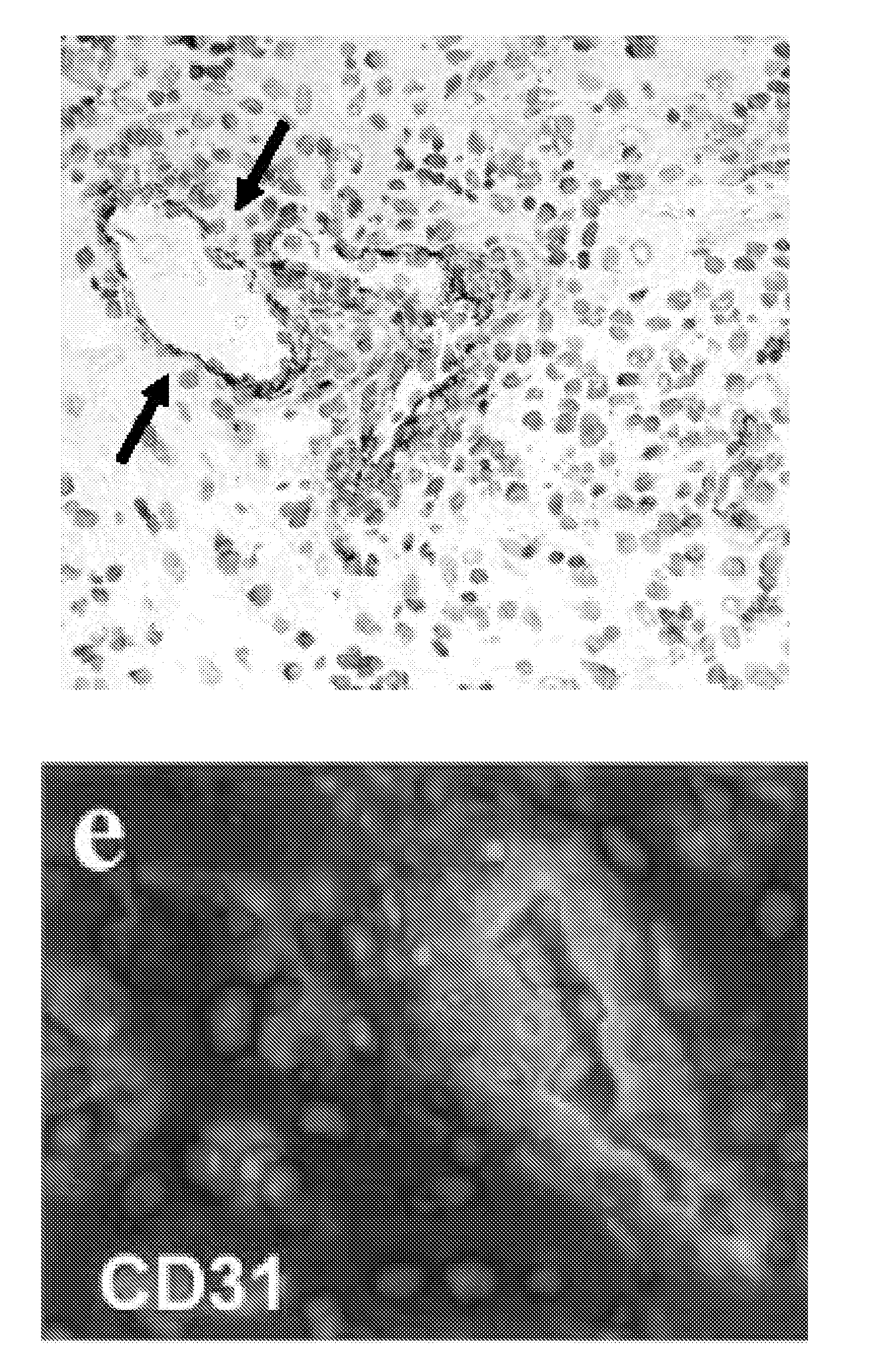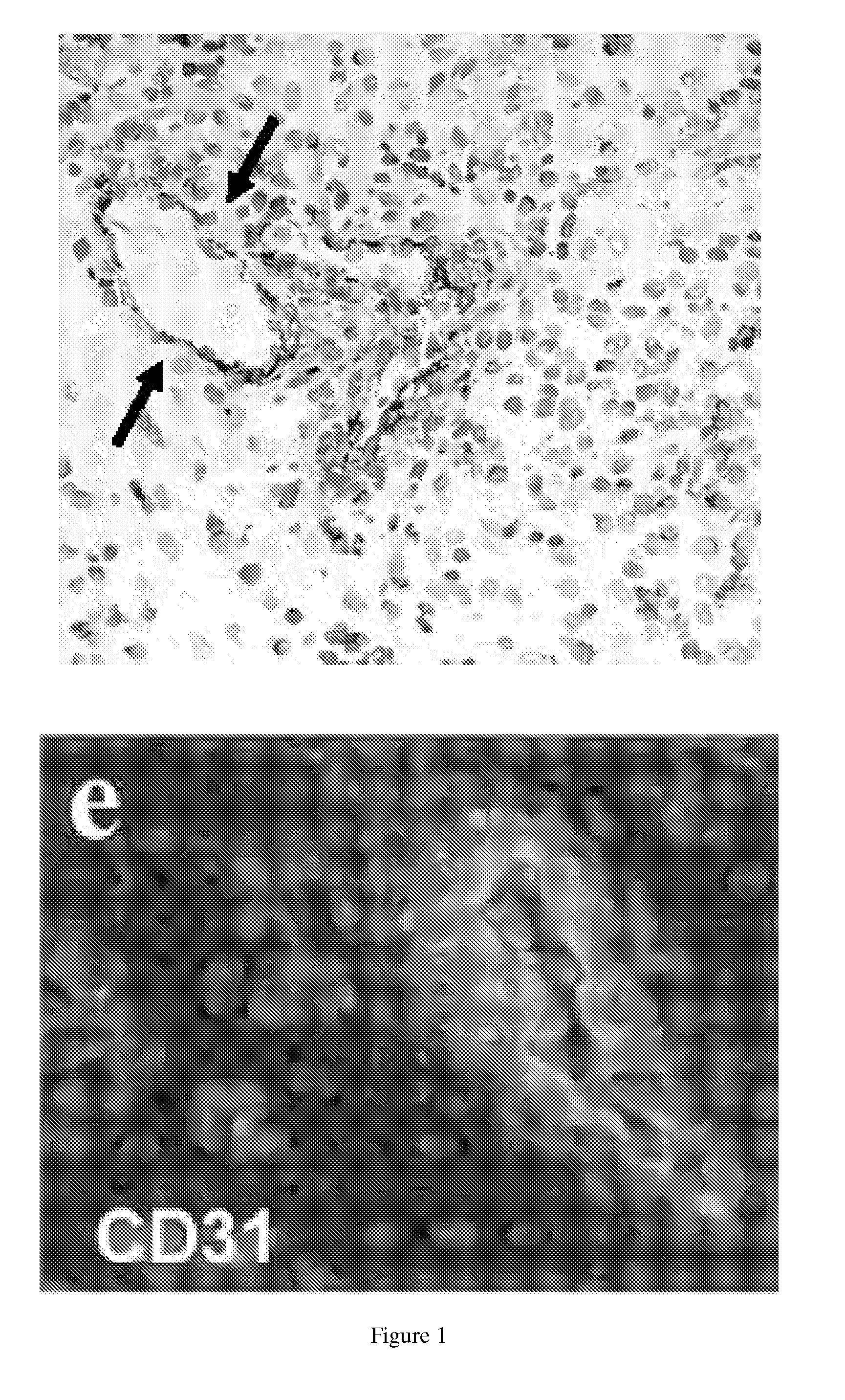Tumor vascular marker-targeted vaccines
- Summary
- Abstract
- Description
- Claims
- Application Information
AI Technical Summary
Benefits of technology
Problems solved by technology
Method used
Image
Examples
example 1
Expression of TVMs in Control and Tumor Tissue
Plasmid Constructs
[0320]pV1J / TEM-1opt and pV1J / TEM-1 carry the codon usage-optimized and wild-type cDNA of TEM-1, respectively. All constructs encoding TEM-1 fusion proteins were generated by fusing TEM-1 cDNA with the N-terminal domain of FrC (TEM-1-DOM). DOMcoding sequences were obtained by polymerase chain reaction (PCR) amplification from pRep-TeT.C plasmid as described (Rice et al., 2002. Constructs were amplified with the following primers:
(SEQ ID NO: 48)DOM-s: 5′-TATTCTAGATTCAACACCAATTCCATTTTCTTATTC-3′(SEQ ID NO: 49)DOM-a: 5′-TTAGCGGCCGCTAGTTCTGTATCATATCGTAAAGGG-3′
[0321]The amplified DNA was introduced at the 3′ end of the TEM-1 coding sequence, generating plasmid pV1J / TEM-1-DOM.
[0322]The codon usage-optimized cDNAs of DOM was synthesized by oligonucleotide assembly (GENEART, Regensburg, Germany) and cloned in PCR-Script vector (Stratagene, La Jolla, Calif.). To generate pV1J / TEM-1-DOMopt, DOMopt was amplified by PCR with primers ...
example 2
Development of a Mouse Model of Tumor Endothelium Expressing Human (h)TEM1 in Vivo
[0328]Murine immortalized endothelial cells MS1 and H5V, both from C57BL / 6 mouse background, were transduced with hTEM1 and firefly luciferase (fLuc) using lentivirus vectors (FIG. 2). Successful subcutaneous angiosarcoma grafts were established in nude mice using fLucpos H5V. MS1 cells also establish angioma grafts with slow kinetics, which persisted for up to 24 weeks. Furthermore, as can be seen in FIG. 3, hTEM1+ fLucpos MS1 cells admixed with ID8 tumor cells establish fLucpos tumors in the hips of nude mice Immunohistochemistry against hTEM1 using MORAb-004 demonstrated clear expression of hTEM1 on the vasculature in tumors enriched with hTEM1+ MS1 cells (FIG. 4) but not in tumors enriched with hTEM1− MS1 cells. This model allows for testing of human grade tools in vivo in mice.
example 3
PET Targeting of TVM using TVM-Specific Antibody
[0329]MORAb-004 was labeled with iodine-124, a positron emitter with an ideal half-life of 4 days. PET studies with [124I]-labeled antibody demonstrated successful direct attachment of iodine-124 to antibody, with retention of immunobiologic characteristics after labeling, as well as specific targeting of tumors expressing hTEM-1 in the above animal model (FIG. 3). Furthermore, titration studies to evaluate the minimum number of endothelial cells that can be detected by TEM1 PET, showed that two weeks after tumor injection, TEM1 PET can detect tumors that originally contained 5,000 hTEM1+ MS1 cells (data not shown). These experiments indicate that MORAb-004 binds to tumor vasculature expressing TEM1 in vivo, where it effectively delivers radiotracers in a very sensitive and specific manner.
[0330]In one embodiment, a phase I clinical study of TEM1 PET imaging in solid tumors is being conducted using the radiolabelled MORAD-004 described...
PUM
| Property | Measurement | Unit |
|---|---|---|
| Immunogenicity | aaaaa | aaaaa |
| Cytotoxicity | aaaaa | aaaaa |
Abstract
Description
Claims
Application Information
 Login to View More
Login to View More - R&D
- Intellectual Property
- Life Sciences
- Materials
- Tech Scout
- Unparalleled Data Quality
- Higher Quality Content
- 60% Fewer Hallucinations
Browse by: Latest US Patents, China's latest patents, Technical Efficacy Thesaurus, Application Domain, Technology Topic, Popular Technical Reports.
© 2025 PatSnap. All rights reserved.Legal|Privacy policy|Modern Slavery Act Transparency Statement|Sitemap|About US| Contact US: help@patsnap.com



